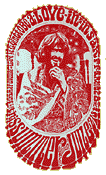
 |
||||||||||||||

|
|||||||||||||||||||||||||||||||
| Howard
Morseburg Poster Pioneer The Story of the Esoteric Poster Company 1960 - 1968 |
|||||||||||||||||||||||||||||||
|
Howard Morseburg (b. 1924) began his career in the art business in the 1950s. He was a World War II veteran who had served in the Merchant Marine and later worked in the book and magazine business. As a young officer during the war, Morseburg was on the "Murmansk Run" to the Soviet Union and other perilous wartime voyages through the submarine-infested North Atlantic. It was one of Morseburg's friends from this time, a young skipper, who was to introduce him to the art business. After the war, this friend became a ship's captain on the Atlantic route, and began importing paintings by European artists to the United States. In Europe, which was still suffering from the economic aftereffects of the war, there was no appreciable market for these artists' work. During the 1950s Morseburg's friend began selling the paintings he imported to galleries and members of the interior design trade who were then developing a wider consumer market for art than had existed before the war. From his base in Seattle, where he was then living, Howard Morseburg followed suit, and began selling these paintings throughout the western United States. In addition to the European paintings he received, Morseburg began representing young American artists. He also became involved in the West Coast printmaking movement. In the late 1950s and early 1960s he started to represent young artists like Wayne Thiebuld, Elton Bennett and Mel Ramos, who created their own hand-pulled prints. It was this interest in printmaking that helped lead to his next venture. |
|||||||||||||||||||||||||||||||
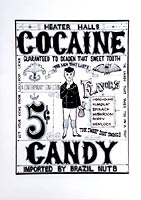 |
 |
||||||||||||||||||||||||||||||
| Cocaine
Candy (1961) Roland Crump Serigraph, 20 1/2" x 15" Esoteric Poster Company |
Berkeley
Fiesta (1967) Greenfield Lithograph,36" x 24" Esoteric Poster Company |
||||||||||||||||||||||||||||||
|
About 1960, Morseburg became interested in creating humorous and satirical posters. At this time, the "Beatnik" movement was in full swing and coffeehouses and jazz clubs were full of Beatniks spouting free-form poetry to the beat of bongo drums. To Morseburg, the Beatnik movement found in Greenwich Village, Seattle, San Francisco and the East Bay was ripe for satire. He met a talented young Disney artist and Imagineer named Roland Crump at a gift shop in the San Fernando Valley, just north of Los Angeles. Crump showed Morseburg the ideas that he had for a series of posters Together, they produced a series of images that satirized the drug culture that was developing among the Beats. In that era, drug use was not widespread and they were chiefly popular with musicians and beatnik hipsters. So, Esoteric Poster's first releases were "Smoke Marijuana," "Fly High, Fly Heroin Airlines" "Cocaine" and "Opium." The next posters were "The Green Gasser," which poked fun at a Beatnik club, and "Big Liz," which was a colorful poster of a Beatnik princess. Those 30" x 24" posters were silk screened in three colors and for posterity's sake they cost $0.50 to produce, were sold to bookstores for only $1.00 and retailed for $1.95. Morseburg personally distributed Esoteric's posters, in the course of his frequent sales trips to visit art galleries. His primary outlets for the posters were the bookstores along the west coast that catered to college students in Berkley, Stanford, Portland, Seattle, San Francisco and San Diego. Morseburg realized that students were the ideal consumers for posters because of their frequent moves and limited budgets that would not allow them to purchase more expensive items. When he began selling to bookstores, none of them were actually selling posters, and Morseburg showed them how they could display posters by stringing clotheslines along the walls and hanging the posters with clothespins. He also sold his posters to stores on upper Grant Street in San Francisco's North Beach neighborhood, at the Farmer's Market in Los Angeles, and later at the Seattle World's Fair where the Beatnik posters went home with foreign visitors. Morseburg has long felt that his early designs, which were displayed in venues popular with artistic young people, influenced other artists and contributed to the creativity that was seen in poster design later in the 1960's. |
|||||||||||||||||||||||||||||||
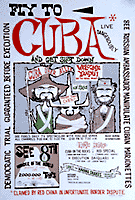 |
|||||||||||||||||||||||||||||||
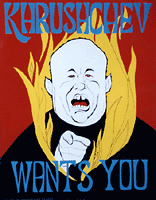 |
|||||||||||||||||||||||||||||||
| We'll
Bury You (Krushchev Wants You) (1961) Roland Crump Serigraph, 29 1/2" x 23 1/4" Esoteric Poster Company |
Fly
to Cuba (1960) Roland Crump Serigraph, 34 1/2" x 23" Esoteric Poster Ccompany |
||||||||||||||||||||||||||||||
|
The next series of Esoteric's posters were political in nature and reflected Morseburg's firmly held belief in freedom and human rights. As a young man, Morseburg was one of the few Americans to visit the Soviet Union during the Second World War. While there, Morseburg met a Polish survivor of Stalin's gulags and a female office worker who felt she would lose her life for working as a liaison with the Yankees. He subsequently lost any false illusions he had about the benefits of the Soviet system. Serving in Europe and meeting those who survived the Nazi regime turned Morseburg into an opponent of all totalitarian systems that denied freedom to their citizens. These experiences gave Morseburg and Roland Crump the impetus to begin a series of posters satirizing life in the Soviet Union and Castro's adoption of Soviet methods in post-revolutionary Cuba. These satirical political posters sold well in college bookstores, until, ironically, those bearing the images of actual totalitarian leaders like Ho Chi Minh, Mao and Lenin replaced them! In Berkley, Mario Salvio and the perhaps no-so-well-named "Free Speech Movement" demanded that the Berkley Bookstore (still located across from Sproul Hall) stop selling the Esoteric line of posters. The sixties were a time of excess and radicalism and no place embodied the sixties ethos more than Berkley. However sadly, the Berkeley Bookstore complied with Salvio's censorship request and discontinued the sale of Esoteric's Posters, much to the dismay of a faction of students. As interest in his satirical posters waned due to changing times, Morseburg worked hard to develop his art gallery and kept working as an artist's agent, selling paintings to galleries in seven western states. The gallery's initial Los Angeles location was in the old Westlake Park neighborhood, just one block from the venerable Chouinard Art School and a few blocks from the Otis Art Institute. These were the major art schools in Los Angeles, and the young art students -- such as the future psychedelic start Rick Griffin -- often came by the gallery to look at the work of established artists. |
|||||||||||||||||||||||||||||||
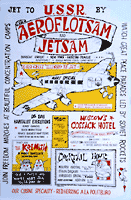 |
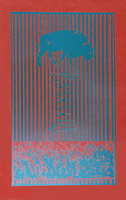 |
||||||||||||||||||||||||||||||
| Jet
to USSR (1967) Greenfield Lithograph, 36" x 24" Esoteric Poster Company |
Buffalo
Springfield (1967) Silkscreen, 22" x 14" |
||||||||||||||||||||||||||||||
| As
the sixties gathered steam, Morseburg began to collaborate with Robert Wendell,
a talented young graphic artist and poster designer. Wendell was a gifted
printmaker, and in 1967 he designed several posters and updated some of
Crump's earlier designs. Some of these later posters were published by Esoteric
Poster Company and printed using the silkscreen process, hence the name
"Gawdawful Graphics" or "Blue Light Press" that often
appeared on the individual posters with the Esoteric name.
During the 1960s, one of Howard Morseburg's gallery accounts was the Moore Gallery on Sutter Street in San Francisco. The famous "Joint Show" was held at the Moore Gallery in July of 1967. The "Joint Show" was a group exhibition of work by the five most famous San Francisco poster artists, including Alton Kelley, Stanly Mouse, Victor Moscoso, Rick Griffin and Wes Wilson. Morseburg viewed the exhibition and in lieu of the money that Moore owed him, Morseburg accepted a selection of the Joint Show posters, which were eventually stored with his own remaining inventory. |
|||||||||||||||||||||||||||||||
 |
 |
||||||||||||||||||||||||||||||
| Joint
Show (1967) Rick Griffin Lithograph, 28" x 22" California Litho Plate |
Trainwheel Mouse/Kelley Lithograph, 28" x 22" California Litho Plate |
||||||||||||||||||||||||||||||
|
Unfortunately, Esoteric's psychedelic poster business was not a striking financial success. The company did not have a highly evolved method of distribution (like Chet Helm's Family Dog or Bill Graham's Fillmore). Furthermore, the silkscreen method of printing is a fine arts process, which is slow and costly and does not lend itself to producing large quantities of prints. Esoteric Poster's rock and roll and satirical drug posters were thus only distributed to a few book stores, some head shops, and sold at a few gift shows. They never received the mainstream distribution or the recognition that they deserved. By 1968, the poster venture was finished and the remaining stock ended up in Morseburg's basement on Wilshire Boulevard. Eventually,
Howard Morseburg gave the poster inventory to his three children with
the idea that they might eventually find a market for them. In the 1970s,
Jeffrey Morseburg carefully packaged all of the remaining posters as he
began to realize that there was a collector market for these vestiges
of the psychedelic era. The Morseburg family remained active in the fine
art business, but had neither an efficient means of distributing its remaining
inventory of posters nor the time to invest in the selling of them. It
is only now, with the direct access that the web affords, that it has
become possible for sellers and collectors to find each other in an inexpensive
and efficient way. And so we are pleased to bring to you these rare, original
examples of 1960s' psychedelic posters. |
|||||||||||||||||||||||||||||||
| Jeffrey Morseburg | |||||||||||||||||||||||||||||||
| Copyright
2003 Jeffrey Morseburg Not to be reproduced without the author's specific permission. |
|||||||||||||||||||||||||||||||